#the full explaination involves a lot of da lore
Explore tagged Tumblr posts
Text
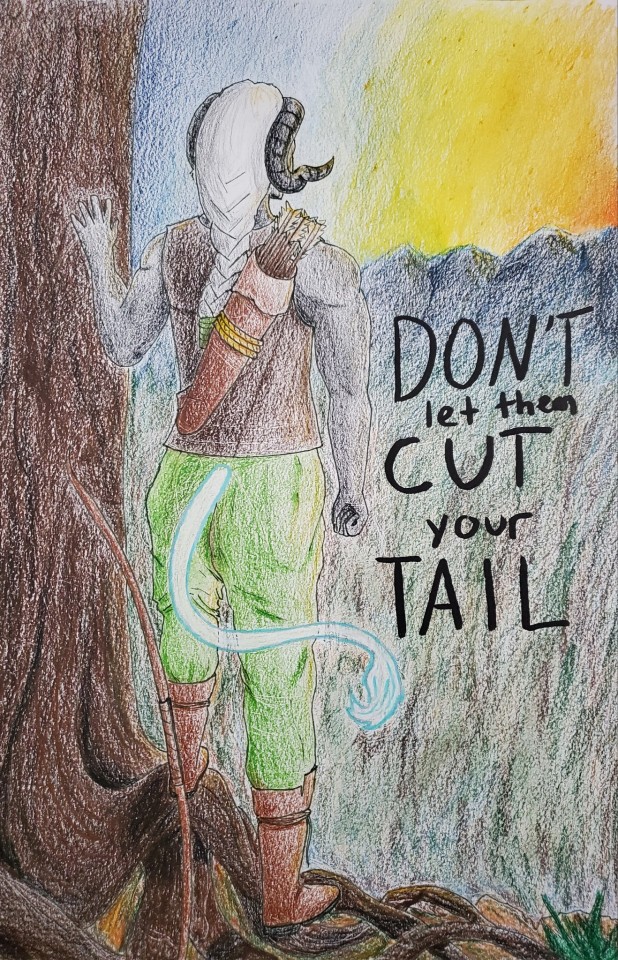
Born young and wild,
Don't let them cut your tail.
Just a pinch of salt in the wound, you'll be fine.
"Wolves of the Revolution", The Arcadian Wild
#popsicle art#sataa#sectari#the tail is not and has never been real btw#it is a metaphorical tail; a symbolic tail#the full explaination involves a lot of da lore#but in essence:#they hate you for what you are but they could never understand it#everyone sees you as a beast and maybe you are a little wild but it isnt a horror or a tragedy to be you
2 notes
·
View notes
Text
DA2: Xenon and his Black Emporium
[This is part of the series “Playing DA like an archaeologist”]
Tales of a mysterious underground shop run by an immortal—perhaps undead—proprietor who peddles impossible and implausible goods […] No reputable source has ever found it and none ever will, because it does not exist.
You will, of course, hear the standard justifications: it appears only to the worthy, it appears only to the invited, it is hidden by blood magic, it exists only in the Fade. Rubbish. There is no magic that can hide an entire shop full of trinkets from the eyes of a Seeker of Truth. And I am not just saying that because I searched for six months and didn't find it; shut up, Tristan.
—From a letter by Seeker Benedict to Divine Justinia V.
The codex of the Black Emporium implies that this shop is truly hidden by powerful magic if a Seeker of Truth [who, thanks to DAI and Asunder, we know they have strong unique sensory powers] couldn't find it. What it's a fact is that Hawke and the Inquisitor found it and visited it, the place exists. Now, the description of the codex makes me _speculate_ that it could be hidden in a pocket of the Fade, a small plane like the Crossroads: if blood magic were involved, a Seeker could find it. DAI and books like Asunder showed us how strong a Seeker's powers are. However, they have not senses to identify places in the in-between the waking world and the Fade. In fact, we know by the book The Masked Empire that these places are very anti-human [non-friendly towards humans, I would say]. So this kind of space could pass invisible to a very powerful Seeker. In any case, that's total speculation on my part. It’s fun to play with the idea, though.
Among the emporium’s objects that are interesting, we find many re-used items with no meaning, or if they have it, it escapes me completely.
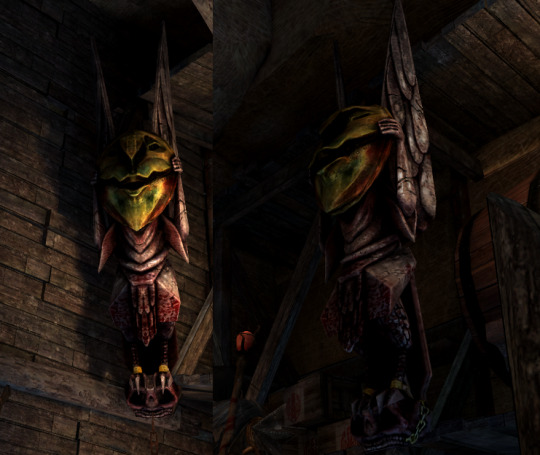
One of those is this masked bird.
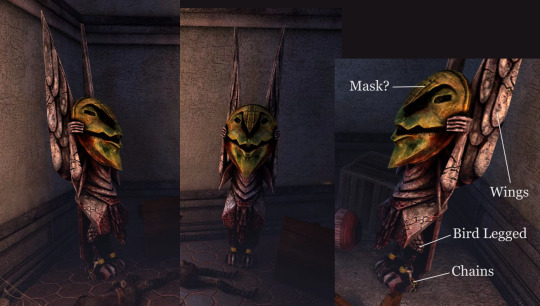
It's a strange creature: a bird-like humanoid with human hands and arms, holding a mask, so we can’t see its face. Its legs are of a bird [bent backwards], with feathers or scales [the resolution of the game is not great for these details], and it has shackles on its ankles. It also has talons and wings.
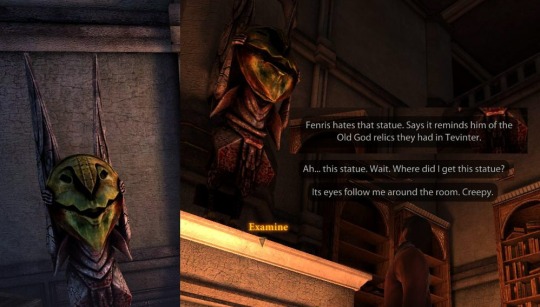
The only hint we have of any potential meaning is given when we find it inside Hawke’s mansion: we know that the statue unsettles Fenris since he claims it’s similar to relics of the old gods in Tevinter. So it’s Tevinter-made? or Elven-made and co-opted by Tevinter? who knows.
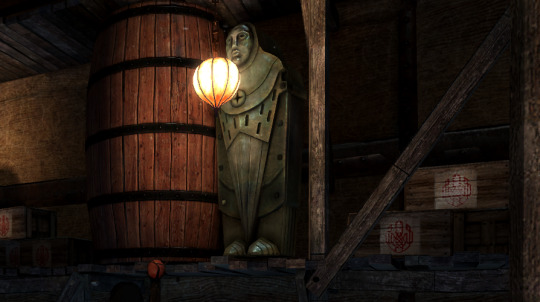
On a less interesting note, there are some iron maidens used several times in many scenarios along DA2. They have a circle on their chest with something that resembles the shape of a star. Nothing more to highlight.
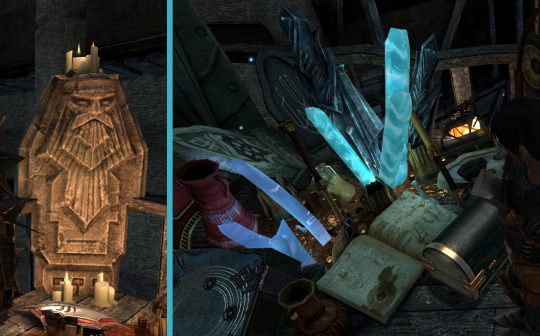
Continuing the less interesting objects: there are a lot of extra items in the emporium such as the dwarven sarcophagus we found in other quests, a lot of general stuff which is more related to fill and decorate the backgrounds than to have any lore significance, and many other objects spread along the Emporium with strange funny codex that can be found in the wiki and I don't think they require attention.
Now, what truly caught my attention in this place were 3 things:
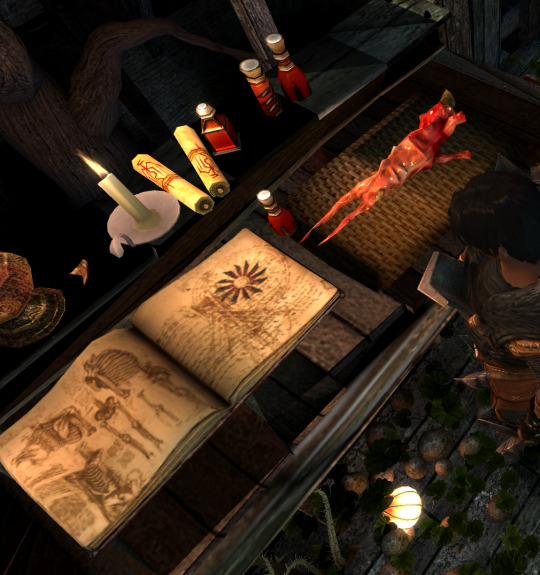
A piece of red lyrium on the desk, as a component for potions, like it's a totally normal component. After analysing DA2, and specially in the posts of the Gallows or the one about Red Lyrium, I have the suspicion that Red Lyrium m ay have been used by Tevinter when Kirkwall was still called Emerius, which would explain why Xenon has pieces of this element even when we visit him before the expedition to the Deep Roads [or maybe it’s just a dev’s overlook. It can happen].
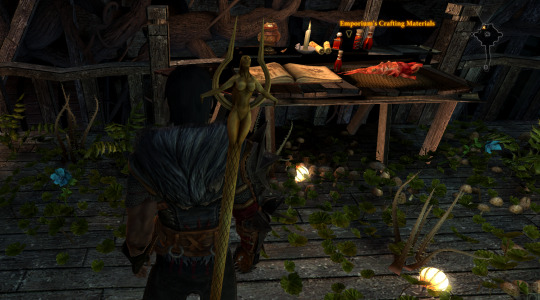
However, the detail is very well-thought: because it's red lyrium, and may have some effect on the Fade around it, we see the desk surrounded by Felandaris, an herb that only grows where the Fade is thin.
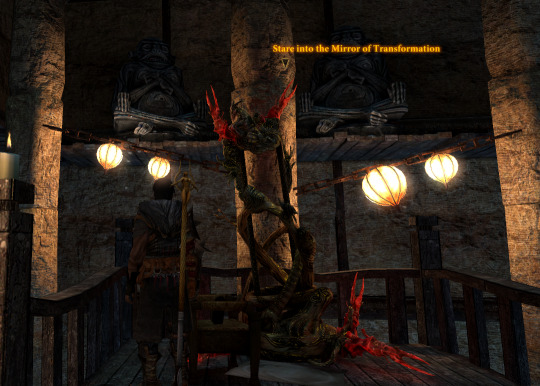
The most shocking part of this DLC, lore-wise, is that Xenon has an eluvian infected with red lyrium, being the Mirror of Transformation. Yes, it’s close to the concept that, if the Fade alterations have effects in reality, and an eluvian allows you to have access to the Fade, maybe a mirror in this twisted/corrupted condition can alter its reflection in the Fade and see the consequences in the waking world. Something along those lines. As it couldn’t get worse, in the background, on a shelf, we see two of those cursed statues [see post of Strange Idol].
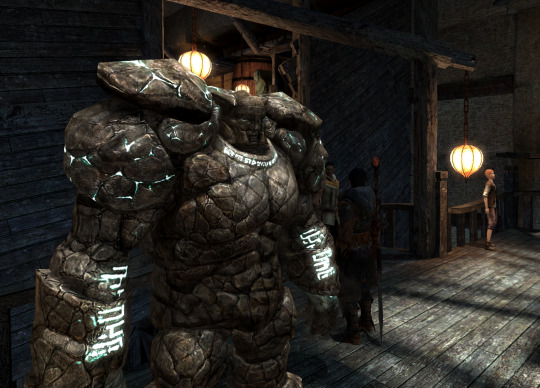
There is also a golem that, according to the emporium codex, is the defence that Xenon has when someone wants to steal something. I don’t think there is much to say about it.
Now we move on to the most interesting thing in this place: Xenon himself, the owner of the Black Emporium.
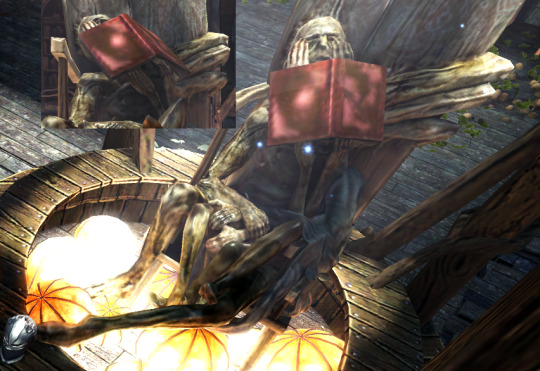
Seeing his design is fabulous. There is no way to understand what happened to him: he is a mess of limbs.
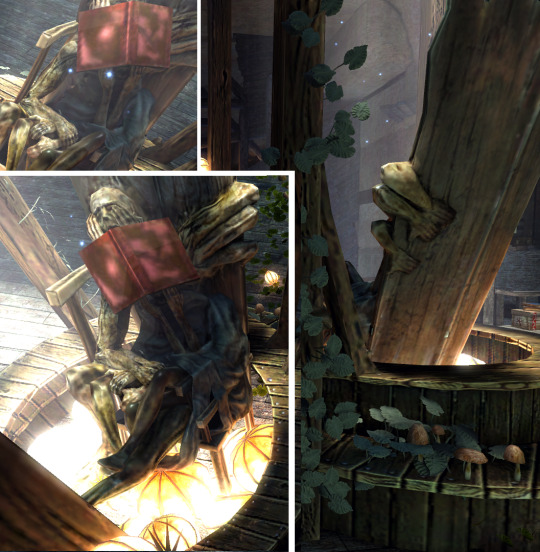
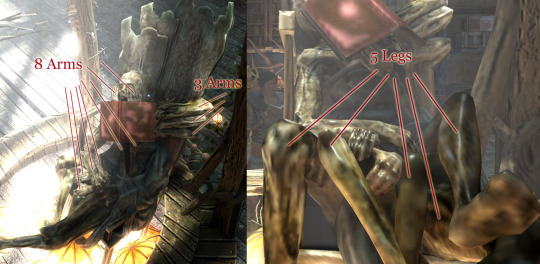
DA2 Xenon has the following characteristics: I can count 11 arms and 5 legs. Below the book there is another face, screaming, covering its eye sockets with two additional hands. It looks like small humanoid bodies were stuck or absorbed by Xenon’s core. Part of the 3 arms that reach the back of the chair are fused with the chair as well.
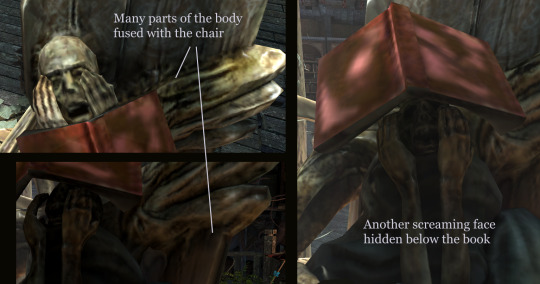
If we see the detail, his limbs are fused with the chair suggesting petrifaction?
What is curious to me was that extra head below the red book. It looks like that, in order to keep his youth, Xenon may have used magic to fuse his body with other living creatures, adding more and more limbs to his body with each procedure. Once more, this idea resembles part of the narration of The Horror of Hormak, which features monstrosities with many limbs as a consequence of fusing living creatures. As a speculation, I think there is a remote possibility that Xenon has been close to this kind of elvhenan magic, in his many experiments to seek a solution to his state.
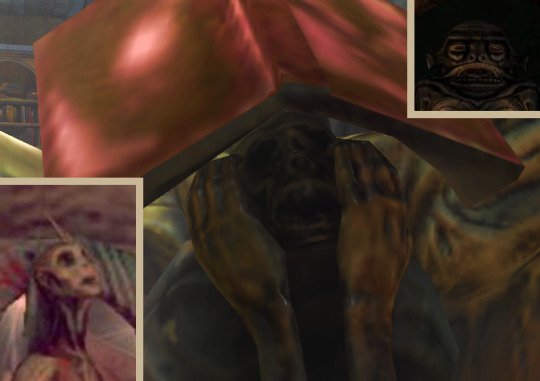
Just to discard an excess of hypothesis and wild speculation, for a moment I thought that the screaming face under the book could be similar to the cursed strange idol, or to the red lyrium idol. I placed these objects in the same picture to compare easily… and we can see there is no relationship at all. However, it’s disturbing that the small head comes from his heart, which is from where the red idol was retaken from Meredith’s remains [Tevinter Nights]. Maybe it’s not the exact same thing, but a similar procedure or the imitation of it.
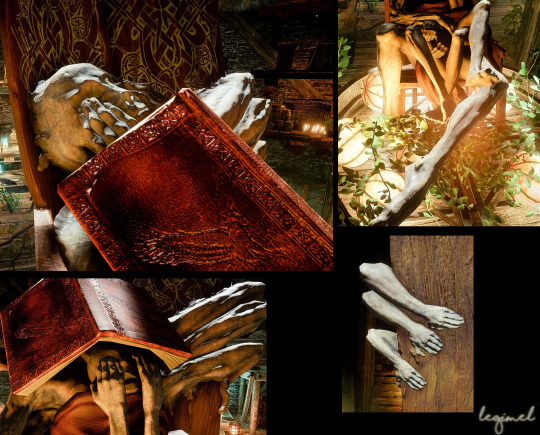
DAI Screenshots belong to https://twitter.com/Legimel
I did not replay DAI yet, but I picked some screenshots to compare and remove some doubts I was having in terms of design. DAI Xenon is not different to DA2 Xenon, the effect of his body getting fused with the chair is more notorious, as all the details are, including the small screaming head below the book. So, Xenon is consistent through both games, at a simple glance. I’ll do a detailed post of him once I replay DAI.
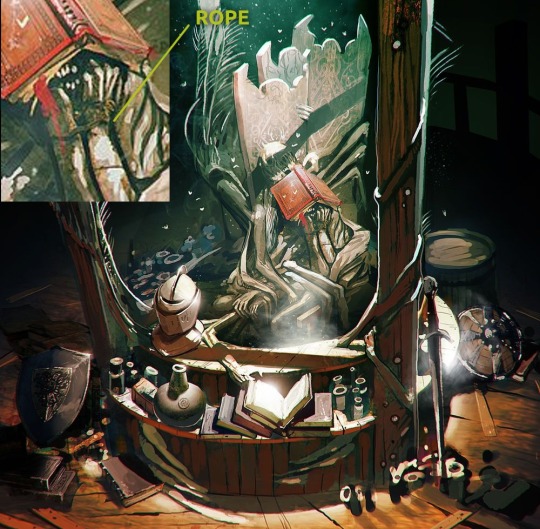
I checked the art books to see if I could find something interesting too. What I found is that Xenon’s tarot card has not much to offer with the exception of a small detail: the hands that cover the small screaming head below the book seem to be tied, giving the impression that, maybe, those bodies attached to Xenon were unwillingly people [fusing with him in an attempt to keep his youth?].
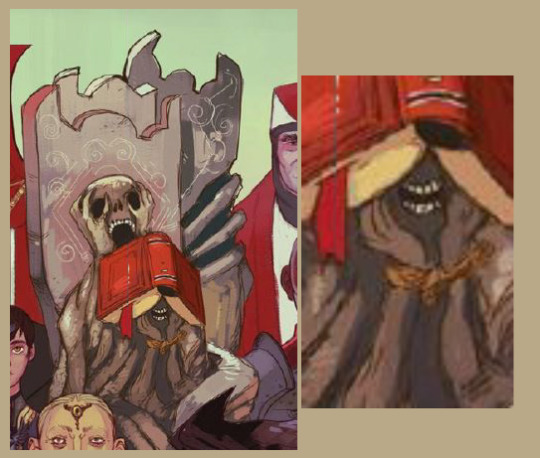
In the book Art of Inquisition, we see the same detail again: those hands are tied with a rope.
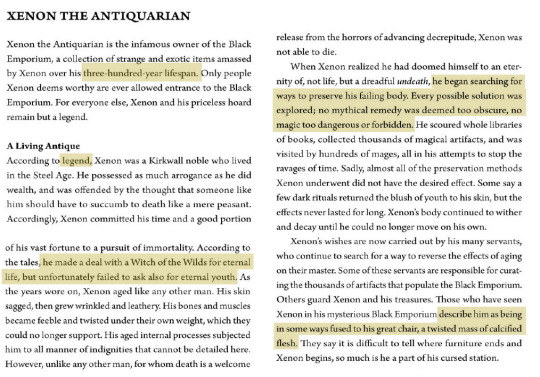
When it comes to the information in these books, there is nothing interesting. Everything is narrated in a very vague way.
The codex about him offer little important information: all of them are written by unreliable narrators that know nothing about the true past of Xenon. [Codex in DA2, and in DAI]
Like in the book of World of Thedas, there are some lines, written in a very vague way, that suggest [if this can even be considered true] that the Antivan Witch of the Wild granted him eternal life without youth. This would mean that Yavanna and her dragons [which blood is the blood of the world] may have been related to all this, but seems very unlikely. Could she be that powerful? Probably Xenon will remain a mystery forever.
[Index page of Dragon Age Lore ]
8 notes
·
View notes
Text
KH3 Plot Holes and Analyzing the Weapon Names of Organization XIII (Part 1)
After beating KH3, I was immensely disappointed. All I could think of was how poor the story was, how many plot holes there were, how many questions I had that should have been answered, how unsatisfying so many character arcs felt, and how little closure we got on so many topics Nomura previously promised answers to. Almost all the issues that felt unsatisfying or poorly explained are now being tied to the next game, when by all rights they should have been resolved in this one. And most of these subplots are now being tied to Union X, when they had no foreshadowing that they involved that game’s lore or original characters ever before.
One of the main topics I felt NO closure on was Ansem’s six apprentices, as well as Lea and Isa’s connection to them. We know Nomura originally intended 0.2 A Fragmentary Passage to be a full-volume game, and that it would have made the characters “more complicated”. Given the scenes chosen in Blank Points, it seems we would have learned much more about the apprentices and their fall to darkness. Here are the things Nomura said in interviews that indicate how much more we were supposed to learn about the original Organization XIII:
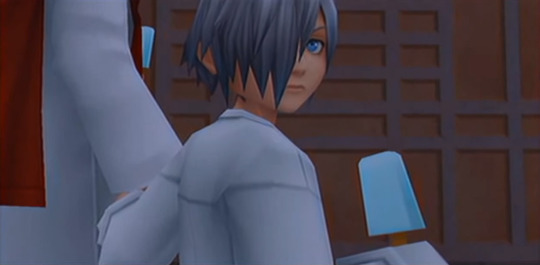
What sort of people were Organization members 3-8 as humans?
We know now that they had ordinary lives in Radiant Garden. In BbS we’ve seen one part of Xigbar’s past, as well as members 3-8. 3-6 were apprentices under Ansem the Wise and did things like act as guardsmen, but Axel and Saïx were just young boys who were friends.
What happened to Ansem the Wise?
He is left wandering in the Realm of Darkness. Ansem the Wise, who had been banished to the Realm of Nothingness by his six apprentices, in KHII, wanted to release the Kingdom Hearts made from people’s hearts that the Nobodies of his apprentices had made. The machine that he used for that ended up exploding, taking him with it. It looked as though he died, but we know from the secret event in BbS that he was sent into the Realm of Darkness. Ansem tried to encode the heart’s form into data with his machine, but it didn’t go as planned and the machine went berserk. Ansem the Wise was thrust into the Realm of Darkness, forgetting all of his memories except those concerning Sora.
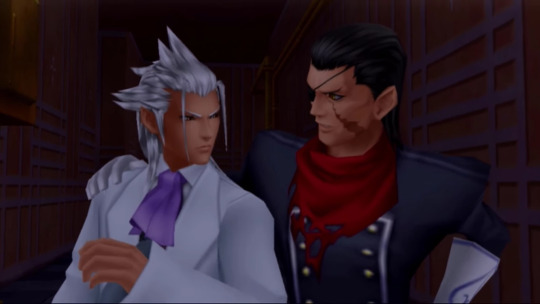
Did Apprentice Xehanort really lose his memories? Master Xehanort commandeered Terra’s body, and became Ansem the Wise’s apprentice. According to Secret Ansem Report 1 From KHII, the young man asked to become a test subject for Ansem’s research so he could get his memories back. After that they began the study of darkness, but did he really lose his memories? And are those memories Terra’s or Master Xehanort’s?
Why is Xemnas searching for The Chamber of Waking?
To find Ventus. The Chamber of Waking is the room where Aqua leaves Ventus sleeping in Last Episode, and is a part of Castle Oblivion. As you can see from Xemnas calling Aqua’s armor his “friend”, it seems Xemnas has Terra’s memories and he is searching for Ventus, making the other Organization members look for the Chamber of Waking. The only one who can solve the mysteries of Castle Oblivion is Aqua, though, so the Organization was never able to find it.
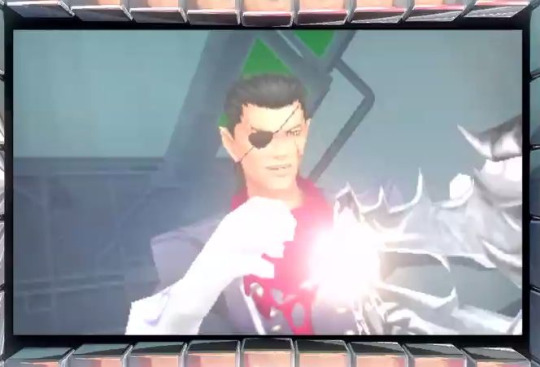
What are the details of Ansem’s apprentices fall into darkness? Most of what had happened with Ansem’s apprentices before their fall into darkness is unknown, aside from what was touched upon in Secret Ansem Reports. And the mystery of “the plan that was decided on after Axel and Saix entered the Organization” that was talked about in the Secret Reports in Days still remains. According to Nomura there is still much about the Organization’s humans that has yet to be said.
Where is Master Xehanort’s keyblade? As was stated in Secret Ansem Report 13 in KHII, while studying darkness the young Xehanort opened the door to the heart of Radiant Garden. This would have been possible if he had a keyblade, but according to the Ansem Reports 4-8 in KH, he did not yet know about the keyblade at the time. In Last Episode Master Xehanort used his keyblade up until going to the world of darkness, but what happened to it after that...?
Roxas, the "Sora + Ventus" Nobody, was able to use a Keyblade. In contrast Xemnas, the "Terra + Master Xehanort" Nobody, wasn't able to use a Keyblade. Why is this?
I'd rather that point remain a mystery. It's possible that he intentionally wasn't using one.

The King seems to come in contact with Kairi, the heroine from Kingdom Hearts I.
Because the story takes place before Kingdom Hearts I, the part about Kairi couldn’t be ignored. However, the cause for her going to Destiny Island and her detailed history are not revealed. It draws on the mysterious special existence.
Why did Kairi end up with Sora and Riku?
It has to do with Aqua’s “magic”. Nine years before KH, Kairi was thrust into the outside world, and found herself on Sora and Riku’s world. Ansem Seeker of Darkness thought that she had been able to search for a keyblade wielder, but what actually saved her was the magic spell Aqua had put on her.
Lea and Isa also lived in Radiant Garden apart from the Organization members up to No.6.
That’s right, however they are merely residents at this time. They’re just innocent Frisbee playing boys.
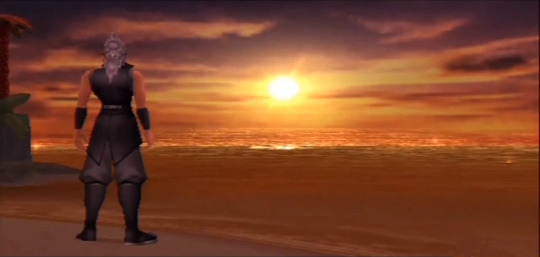
Where did the Organization’s coat and mark come from?
Xemnas remembering his human years. One year after BbS, Xehanort as well as five other apprentices toss aside their hearts. Then the Nobody Xemnas was born, and the Organization which he creates takes a lot of things from his memories as a human. But as Xemnas had two people who he was, Terra and Master Xehanort, he takes from both of their memories.
In KH BbS, Master Xehanort's goal behind opening Kingdom Hearts was to "create a new world." But in this game, he says it is to "reset the world." Why the difference? What was revealed in this game was another piece of the truth: his goal was "this world is no longer any good, and we have to recreate it from scratch."
We are interested in why Xehanort would come to such a conclusion. At first, I did want to use a next game to dig down into how Xehanort went from that simple boy playing the chess-like game to an admirer of the darkness. But, if I do that, then the Dark Seeker Chronicle wouldn't have ended with KH3 after all (laughs.) Some ideas had solidified to a degree, but it's shelved for now.

The Dark Seeker arc has concluded, but since when have you been thinking about the conclusion?
The Dark Seeker arc has been a concept ever since KH2. In those days, I just kind of threw together and decided an outline. I was often told by the manga artist that they felt "the characters come alive however they want", and some parts did change from their original conceptualization, but in the grand scheme of things not much changed.
Emphasis mine on the mention of things changing from their original conceptualization. There are many details I suspect were changed, while keeping the overall grand scheme the same. I believe there was supposed to be way more backstory to the Organization than what we actually got. So I decided to look for possible clues in the story. 358/2 Days revolves around Organization XIII and I noticed that the names of their weapons are very unique and interesting. They may very well shed light on what the members’ backstories could have been.

In Days, the weapons are sorted into specific Gear types. The are three types that are the most interesting and most defining for the character. The first is Pandora Gear, “a formidable weapon with exceptional capabilities.” For Organization members, this Gear grants them two of their most powerful weapons; the color scheme is the same for all of the Organization's weapons provided by the Pandora's Gear, consisting of black, gold, and blue or red.
The second is Zero Gear, “a powerful weapon that draws forth its wielder's true worth.” The Zero Gear is emblazoned with the Nobody insignia, signifying that for the Organization members, as well as others who wear the Black Coat, this gear produces that character's signature weapon.
And finally, perhaps the MOST interesting is Mystery Gear “a weapon that draws forth its wielder's personality.” When equipped, it transforms the user's weapon into one that "draws forth its wielder's true personality.” Were these weapons a hint at the mysteries of Organization XIII’s true personalities? I will analyze all of Organization XIII’s weapons, but not necessarily in order.
No. IX - Demyx (Melodious Nocturne)

Prefers to kick back with his sitar, and leave the dirty work to the water under his command.
Not all the Organization members have weapon names that are super interesting, possibly indicating a fleshed out backstory was not thought of for all of them during the creation of 358/2 Days.
Most of Demyx’s Sitars are named after musical or rock and roll terms. Basic Model, Tune-Up, Quartet, Overture, Old Hand, Da Capo, Power Chord, Fermata, Interlude, Serenade, Songbird, Rise to Fame, Rock Star, Eight-Finger, Concerto, Harmonics, Million Bucks, Fortissimo, Up to Eleven, Arpeggio, and Prince of Awesome (joke weapon). The joke weapon is a tennis racket and its name is a reference to the "Prince" brand of rackets, which have the general shape of Demyx's sitar. It may also refer to the anime and manga series, The Prince of Tennis.
Demyx’s Pandora Gear is Sanctuary, a reference to the English version of Utada Hikaru’s opening song. His Zero Gear is Arpeggio; musically, an arpeggio is the playing of notes from a single chord in rapid succession. Dance water, dance! His Mystery Gear is After School, a broom. It is probably a reference to after-school clean-up of a classroom, which is common in Japanese schools. For some, this assignment may have been given as punishment for getting caught sleeping in class. Because it brings out Demyx's true personality, it may be a reference to his tendency to "sweep things under the rug" or evidence that he was a rather ordinary person compared to the rest of the Organization.
No. XII - Larxene (The Savage Nymph)

Wields sharp knives and a sharper tongue. Her lightning strikes as quick as her temper.
All of Larxene’s knives have French names relating to storms and heavenly bodies. Her weapon names translate to Sharp Edge, Thunderstorm, Whirlwind, Tempest, Carmine, Meteor, Star, Irregular, Dissonance, Eruption, Setting Sun, Indigo, Wave, Flood, Squall, Typhoon, Eradicate, Southern Cross, Luminous, Moonlight, and Damselfly (joke weapon).
Some of her weapon names seem like a reference to Final Fantasy games. Squall, Lightning, Typhoon (summon) and Luminous (the engine). Other than that, they seem to describe a stormy femme fatale personality. The Tempest is a play that was written by William Shakespeare in the early 1600s. When the play begins, Prospero, the deposed Duke of Milan, and his teenage daughter, Miranda, live on a remote island where they have been stranded for the past twelve years. Unbeknownst to them, the storm is the work of Prospero, who aims to shipwreck them on his island. It is a tale of magic, deception, revenge, and marriage. The main political theme of the play is gaining power and control over others. A reference to her role in Castle Oblivion?
Her Pandora Gear is Vol de Nuit or Night Flight in English. Vol de Nuit is the name of a book from the French author Antoine de Saint Exupéry, in which a pilot is trapped in a storm. A major theme of the novel is whether doing what is necessary to meet a long-term goal is more important than an individual's life. Her Zero Gear is Lightning. Her Mystery Gear is Light Bulb. The light bulb is the symbol of invention, intelligence, and a great idea. Perhaps Larxene was a lot more complex and intelligent than we have gotten a chance to see.
No. XI - Marluxia (Graceful Assassin)

In the arc of his scythe, flowers grow and all else perishes. His pretty face hides ugly motives.
All of Marluxia’s weapons are named after flowers along with a typically negative adjective. The only exception is the Stirring Ladle, one of his joke weapons. His weapons allude to some tragic backstory, as well as his inner resolve.
The rest of his weapons are Fickle Erica, Jilted Anemone, Proud Amaryllis, Mad Safflower, Poor Melissa, Tragic Allium, Mournful Cineraria, Pseudo Silene, Faithless Digitalis, Grim Muscari, Docile Vallota, Quiet Belladonna, Parting Ipheion, Lofty Gerbera, Gallant Achillea, Noble Peony, Fearsome Anise, Vindictive Thistle, Fair Helianthus, and Solemn Magnolia.
His Pandora Gear is Hallowed Lotus.The lotus flower is regarded in many different cultures, especially in eastern religions, as a symbol of purity, enlightenment, self-regeneration and rebirth. His Zero Gear is Graceful Dahlia. The dahlia is known to represent one who stands strong in his/her sacred values. His Mystery Gear is Dainty Bellflowers or Dainty Liliies-of-the Valley in Japanese. Bellflowers symbolize unwavering love. The Lily of the valley means "return to happiness" and most often symbolizes chastity, purity, happiness, luck and humility. It does apparently indicate that Marluxia was not conceived as an evil character, even as early as 358/2 Days’ writing.
No. X - Luxord (Gambler of Fate)

Life, to him, is just a game to be won...and he has all the time in the world to do it.
Nearly all of Luxord’s weapons are named after tarot cards, with the exception of his joke weapon. His joke weapon is Finest Fantasy 13, which takes the appearance of many compact discs; an obvious reference to how the PS1 Final Fantasy games came on multiple discs.
The rest of his cards are named after the Major Arcana of the Tarot. The Fool, The Magician, The Star, The Moon, Justice, The Hierophant, The World, Temperance, The High Priestess, The Tower, The Hanged Man, Death, The Hermit, Strength, The Lovers, The Chariot, The Sun, The Devil, The Empress, and The Emperor.
His Zero Gear is Fair Game, his main weapon from Kingdom Hearts II and not related to the Tarot. His Mystery Gear is High Roller’s Secret. Instead of being related to the Tarot, its name and design is drawn from the superstition that four-leaf clovers are blessed with good luck. His Pandora’s Gear is The Joker. The Joker is often compared to The Fool in the Tarot deck. They share many similarities both in appearance and play function.
Nomura said that the “Wild Card” that Luxord gave Sora while he was fading away will come into play later and that perhaps it holds the key to Sora's revival. The Fool Arcana is often also called the Wild Card in Tarot decks. The Fool represents new beginnings, having faith in the future, being inexperienced, not knowing what to expect, having beginner's luck, improvisation and believing in the universe.
Luxord wrote a report in 358/2 Days indicating he admires children for some reason:
“I find myself envying the children. Perhaps some fundamental difference exists between those who become Nobodies as adults and otherwise. The longer you have lived, the more you are positioned to lose with such a gamble. But a child can look forward, unafraid even in the face of immeasurable odds. I doubt they even see life as a gamble the way we do.”
#anti kh3#kh spoilers#kh meta#kingdom hearts meta#larxene#kh demyx#kh larxene#kh org#organization xiii#kh3 spoilers#marluxia#luxord#kh3#kingdom hearts#kingdom hearts 358/2 days
41 notes
·
View notes
Text
I'd like to consider myself fairly knowledgable about Mark’s WKM lore and the related projects (WMLW, Damien) I’ve watched the explanations a few times. (I’ll link them first just in case you’d rather watch them yourself before reading my MUCH shorter, less detailed explanation)
>>WKM explanation<<
>>WMLW explanation<<
>>DAMIEN explanation<<
My explanation for WKM, DAMIEN, and WMLW:
Actor Mark invites a few of his estranged friends to a party at his manor, out of the blue, with ulterior motives. It turns out that the Colonel, William J. Barnum, has been having an affair with Actor Mark’s wife, Celine. The Actor has devised a plan to enact revenge on both Celine and the Colonel.
There is an “entity” residing in Mark’s manor and Mark made a deal with it. (the exact deal isn’t explicitly stated but it involves making sure Celine “can’t go breaking anyone’s heart ever again” and allowing the Entity to possess his body after everything is said and done.) The Entity makes Mark effectively immortal allowing Mark to “kill” himself and survive over and over, hence when the detective states that he has been “poisoned, beaten, strangled, drowned and shot (in that order)” and that he was also stabbed 37 times. This was all in order to perfect his plan.
Mark originally intended to have Actor!Mark lure William down to the basement cellar to play a game of Russian roulette while sharing wine. William, not realizing the gun was actually loaded, shoots and “kills” Actor!Mark. Hence the broken wine bottle. A reference that is canonized with the statements of the WAIA in the newest vid:
“A man goes to a party. This man met an old friend. The two friends shared some wine. The two friends played a game. The most dangerous game. *gunshot-like noise followed by red lighting* I didn’t know the gun was loaded. I didn’t know. Was it my fault?”
After the party, Actor!Mark’s body is found. The body moves afterward bc Mark is not actually “dead”. The longer they stay in the house the more power the Actor and the Entity have over the individuals in it. Mark explained that he originally wanted to convey that Celine, having spent a lot of time in the house, was now a “seer”/ connected to the “spirit world”. Thus the “Don’t trust the seer” note in the Detective’s room. William, has developed the ability to “teleport” throughout the house unknowingly.
Abe (the Detective) makes a journey throughout the house with the DA/viewer (us), showing the layout of the house. But the room that the Detective had been working in is not shown. This is bc the Entity has been hiding it from the group. During the scene when the DA/viewer goes into the “upside down”, we are led to the Detective’s room. Having been unknowingly teleporting throughout the house, disrupting Actor!Mark’s plan, William also stumbles onto the room. This throws a wrench into Mark’s plan causing William to think the Detective was the mastermind behind everything.
Backtracking a bit, Celine and Damien go off together and encounter the Entity while reaching into the “spirit world” for answers. The Entity (or the Actor) kills Damien and possesses Celine’s body. Actor!Mark possess Damien’s body, abandoning his horribly broken body. By this point everyone is already trapped in the house.
William ends up killing Abe (the detective) and the DA/us in the struggle.
“It was an accident, I swear”
After a full night of William watching over our dead body, mourning his actions and the loss of his friends and love, he watches us rise from the floor seemingly unharmed and alive. The Entity, having been lied to by Actor!Mark, possesses our body along with the spiritual remains of Celine and Damien after convincing the DA/us to let them do so. After we are revived the three of them, no longer needing us, pushes us out trapping us in the “mirror”. The three of them, possessing our body, become “Darkiplier” and go on the quest to hunt Actor!Mark down and seek revenge.
(I put quotations around mirror bc Mark explains that we/the DA are now the “viewer”. Unable to change anything, unable to interact, only able to watch. “You’re right there, behind the glass.” Meaning US, behind the computer, watching Mark’s videos!)
William goes mad from what he’d witnessed and, trapped along with the rest of them in the house and the stories the Actor creates, continually throws a wrench in the Actor’s stories/plans by not following the rules. After all “Life needs a bit of Madness”.
All of he happenings of “DAMIEN” occur before and during the DA/our possession. Celine had created a pocket-reality/story to keep the little piece of Damien that still existed alive. If you haven’t watched DAMIEN I highly recommend it.
WMLW takes place immediately after Abe (the detective) is shot. That is to say, that time is weird once they are trapped in the house. Time, reality, and even death, no longer make sense. For Wilford (previously William) it has been several years and he is already well into his transformation into Wilford. But to Abe it is immediately after he’d been shot. (Mind you, he is not dead. Remember, death doesn’t mean the same thing anymore)
Abe, now playing out a role in a story that the Actor has created, plays the role of the detective. Abe thinks he has been tracking William down but it is revealed that he has no memory of the details when William/Wilford inquires further. This is bc, again, he is simply unknowingly playing a character that the Actor has “written” for him. They are all trapped in stories now. But Wilford doesn’t play by the rules, which is why he is able to “defy” reality. (Wilford not playing by the rules also causes “cracks” in the reality Celine created for Damien allowing Actor!Mark to be able to find his way in to “wake up” Damien. He wanted a “villain” for his stories.)
Wilford is able to give Abe a much needed break from the depressing story the Actor created by pulling him out of it just enough to dance with him.
“Life needed a bit of Madness but why should “death” be any different? But I think the stress is getting to you, you need to unwind. You’re a freshly born fawn trying to find your legs in a world that doesn’t make sense. So, just for tonight, let’s forget about all the chasing and the killing and the shooty-shooty bang-bang GOD you’re a murderer! And, just for tonight, why don’t we....have a little fun?”
Mark also explained that after WMLW the next happenings is “MarkplierTV” lol
Mark says that they all just accept what happened and try to make the most of the new world they live in. Hence the major shift to the fun that is MarkiplierTV.
He said that he originally wanted DAMIEN to end with Wilford finding Dark:
“Oh there you are Damien, I’ve been looking all over for you!” -Wilford
“Oh, Hi Will” -Dark
“You haven’t seen Celine around have you? If I could avoid her, I’d rather do that.” -Wilford (This is bc Celine has changed and was very much seeking revenge on everyone who caused their current predicament)
“She’s sleeping.” -Dark (She’s sleeping bc, as seen in DAMIEN, Damien is taking his “turn” in taking responsibility for hunting Actor!Mark bc it was taking such a toll on Celine.)
“Oh good, great. Well, I’m glad I found you, I’ve got a great new idea.. We’re gonna make a TV show!”
(After a long pause) “...Ok” -Dark
(Que MarkiplierTV) LOL
Well, I THINK I’ve covered just about everything..
Anyone else can feel free to add on/correct if you’d like. Sorry it’s so long! I’m sure there were ways I could have been more succinct.
Ok so I've been subbed to Mark since like 2012 but I don't follow his skits and the like very closely. I've seen Who Killed Markiplier already but even with that I still don't quite follow what the hell is going on.
Can someone who is like really well-versed in all of this break everything down and explain or link a video or something cuz I'm completely lost.
#markiplier#WKM#who killed markiplier#DAMIEN#celine#actor!mark#WMLW#wilford motherloving warfstache#wilford warfstache#darkplier#The Warfstache Automated Interview Automaton#WAIA#markiplier egos
30 notes
·
View notes
Text
Blast from the Past: Dragon Age II, Why the Mage Templar Conflict Fails
So Dragon Age II is the best game in the series (I will fight you) and has the best writing in the entire narrative thus far...but dear god the Mage Templar Conflict is handled terrible. This is also true of inquisition, but it is the main focus of II and I think that is a major reason why people have so many problems with DA:II, because for all of its greatness, so much of the narrative is based on this aspect which just...doesn’t work.
So why is that? I mean the Mage/Templar dynamic was one of the few things in DA;O which is better than DA:II, and there are some really powerful moments involving the conflict in DA:II so why does the overall effort just fall flat? Wait, I know the answer because I am awesome
Basically there were 5 different ways you could have handled this conflict and any one of those could have been a workable story in their own right. But Bioware in their infinite wisdom tried to do all of them and...it was a mess. So I am going to break down the various narratives that could have been and how that should have been told, and why DA:II just doesn’t work
1) A conflict between two equal forces
So the obvious narrative (and the most typical) is present this as a conflict between two roughly equal powers each with valid points, each side has bad elements and each side has some good elements, a very Grey vs. Grey type deal. The player is encouraged to choose which group they/their character personally feels is more valid, but the game is making it clear that the other side is understandable. There is no true good or evil option in terms of which faction you choose. The themes would likely be something like “oh no, look how extremism tears people apart, isn’t it terrible when people won’t listen to the other side” or the same golden mean pablum RPGs do with these sort of narrative
Why this doesn’t work
Well right away, there is the problem where both sides aren’t in fact equal in terms of power. Like at all. The Templar are organized, have the support of the entire society including the church, most of the populace hates mages, and the mages literally are trapped inside a prison tower. The mages are not organized, they don’t have any resources outside their own magic, and of course the Templars can basically mistreat them with impunity (which literally contradicts lore from the first game I might add). You really can’t view this as “Both sides have a point” when the Templars under Maredith are regularly raping, tranquilizing, and just generally abusing the mages.
And what really just kills this “both sides have a point” style conflict is the final choice because...the mages didn’t blow up the CHantry. Anders did it, who is a renegade who explicitly says he is independent. We literally see the head mage both trying to appeal to the Grand Cleric right before and go “WTF man” right after, hawk knows full well that the mages did not do this. So Meredith’s choice to massacre all of the mages (including children) is just loony, like we know full well that she is killing innocent people for a crime they didn’t commit. Even when I play a pro templar hawk I can never really bring myself to side with Meredith because not only is she an obviously crazy evil lunatic with no redeeming qualities, but I can’t imagine any way my character would murder thousands of innocent people for no reason without seeming out of character. I couldn’t even imagine Fenris doing that.
This conflict just can’t be “Both sides have a point” because Meredith is just too fucking psychotic for anybody to really side with her. Unlike Ser Gregor from the first game, Meredith constantly breaks the rules of the chantry itself because she is a paranoid sadist. She uses the rite of tranquility for things that we know in universe the templars shouldn’t use it for, like people speaking out. There is rampant sexual abuse, torture, and...look my point is that the Templars are way too evil and cruel for this to be an equal conflict.
Like if this was Tevinter vs. the Templars, that would be one thing, but this isn’t an equal conflict, when one side is literally locked in their prison,
If Dragon Age wanted this to be a moral situation where neither side was necessarily right or wrong, than they needed to make the conflict more nuanced, the templars should be more like they were in one, and the mages should have actually been doing evil shit, rather than a rogue terrorist. And the final conflict shouldn’t have been “massacre everybody for crime they didn’t commit.”
2) Mages are Right, but lets Understand the Templars
DA:II is obviously trying to tell a story about bigotry and oppression, and at parts sets out to do so in a mature and serious way, and try to explain why the Templars behave as they do. After all, just because a work disagrees with a character doesn’t mean it can’t depict them in a human and understandable way. Dragon Age II could have been trying to explain exactly wy pepole believe things that the game views as wrong, to say “ok yeah, the Templars are wrong, but lets understand their perspective, after all they aren’t cartoonish monsters but people”. And parts of the game seem to do that, for example Fenris is like an anti mage bigot (Magist ?) in a really unacceptable way but he is very understandable. He came from a really bad background and is lashing out his own feelings against the vague group that hurt him, and he is utterly terrified of Tevinter coming to southern Thedas. He is wrong, but the game doesn’t wish to demonize him and wants us to understand how these prejudices grow. We see a similar treatment with Cullen, whose experience in the Origins Circle tower has made him see everything in an extremely black and white perspective, and we pity him even as he commits evil.
Where it went wrong
Well...Meredith is just too fucking awful....again. Unlike many of her minions, she is just kind of an asshole all the way through, from her first appearance she is haughty, callous, paranoid, indifferent and ambitious. We never really see her reasoning or psychology, yeah I know we are told about tragedy in her back story but it never really comes up in scene. She just kinda does awful things because she is an awful person, nothing more complicated than that. For example, punishing people speaking out against her with Tranquility (which again is suppose to be illegal) just makes her out to be a despot, we don’t really see any reason to support her or sympathize with her. And anybody who stays loyal to her comes off as an idiot.
This also makes Grand Cleric Elthina just come off as a complete tool btw, if the Templars are acting out of bounds then the Chanty needs to pull the lease. Again and again Meredith is violating Chantry rules, and Elthina just doesn’t do anything about it, the chantry is strangely passive in all this.
3) Templars bad, Mages response isn’t appropriate
Another approach the game could have done what the Witcher I did, the system perpetuated by the templars is evil and wrong, and really not acceptable, but the mages response to said system isn’t good. The game kinda does this with Anders, who has a very valid point but his extremism makes the whole situation worse and also makes him really unacceptable as a person. Basically ‘Man the Templars are awful and we need to fix this.....why did you blow up the Chantry Anders?”
This version doesn’t actually contradict version 2 btw. Personally I think 2 and 3 combined would be the best way to handle this game
Where it Went Wrong
Well....Anders is the only real anti Templar mage who gets a lot of narrative focus...and he is renegade. I know we run into evil mages who do evil mage things over the course of the game but they are just kinda cartoonishly awful rather than you know...interesting. This narrative would require a lot more focus on the mage resistance and mage responses to the templars in a more human light.
And no, the massive amount of evil Blood Mages don’t count, they are just kind randomly evil douchbags who don’t relate to anything else in the story.
4) Both sides need to come together and unite
In this narrative the conflict is the result of am misunderstanding, and if the two sides just saw thigns from the other’s perspective, a compromise could be reached, and the true evil could be destroyed. Honestly this is the narrative where Meredith makes the most sense, a force of evil that the mages and the templars could unify to fight against because she is so utterly awful. THe ending kinda implies this ending with the templars all going “screw you” to Meredith and her going all Red Lyrium,
Where it went wrong
but then we have a stupid binary moral choice. Enough Said
5) The Templars are totally wrong, VIVA LA REVOLUTION
Finally the game could have just been very black and white, the templars are bad, the Circles are an evil, the mages should rise to fight against their oppressors.
Where it went wrong
This is the only other narrative where Meredith makes sense, and this story would be very clear cut. But again...the presence of Fenris, Cullen and Aveline really implies that this is suppose to be a more complicated conflict than that.
6 notes
·
View notes
Link
The following blog post, unless otherwise noted, was written by a member of Gamasutra’s community. The thoughts and opinions expressed are those of the writer and not Gamasutra or its parent company.
[Note: This post (originally published at darklorde.com) is all about the Engines of Play. If you are not familiar with Taste/Satisfaction Maps and their uses, the Big 5, Self-Determination Theory, etc, I highly recommend watching this video before reading the article. It will make so much more sense. Like, Oh Em Gee.]
A Random Encounter With Relic
I’m in San Francisco. It’s GDC, so the sidewalks of the Moscone Center are packed to bursting with nerds of every stripe. The day is bright. I cross Fourth street, on my way to Moscone North--and someone calls, “Jason!”
I wasn't surprised--it happens to me a lot at GDC. Stay in the games biz for long enough, and GDC will eventually become one big reunion.
What happened next, though, absolutely does not happen every day.
A friendly-faced fella pushes his way out of the crowd, and introduces himself as one Mitch Lagran, a Lead Designer at Relic Entertainment. While I unsuccessfully suppressed my fanboy reaction (because DAWN OF WAR OMFG), Mitch explains that he had attended my Engines of Play talk last year...
...and that Relic had actually implemented the methods I had laid out in that talk.
He claimed that he wanted to thank me for it because it had made a huge difference to their process and was great stuff. I stared at him and tried to think who had put him up to this.
I mean, no one actually implements that stuff. Come on! That’s not how the GDC works!
The GDC is supposed to be a place where you go and listen to people talking about lessons and techniques--ones that you desperately wish you could apply because wow it would make your dev life so much better--and then you go back to your studio and everyone tells you about how yeah maybe that stuff worked for those guys, but that it won’t work here, see, because our situation is different.
And then you sigh, and maybe you try again in three months. Eventually you just go about your business.
GDC is not where RELIC FREAKING ENTERTAINMENT goes to find whole new process for their game conception phases.
But, here’s this guy, and he’s shaking my hand, and he's expressing his gratitude and his appreciation, and I so I play it cool and say, “Really?! You… actually used my stuff?!?"
He nods.
I ask, "Uh… so, what happened?!”
He told me. Later, he sent me a more detailed description of what the results had been. And what he said blew my mind.
So, I asked him if I could write it up, and share it.
A More Proper Introduction
That’s the back story for what this post is about. Ladies and gentlemen, I would like to present something akin to an actual case study for what happens when you apply the Engines of Play (which includes these charts called Taste Maps, and the process of analysis that goes into them) to a real dev environment.
Hrm.
By “actual case study” what I really mean is “the guys at Relic were kind enough to describe in some detail what they did with the ideas, and what the results were”. That isn’t quite a full case study. It's more like a front-line report or something. BUT STILL. CLOSE ENOUGH.
I mean COME ON! How often does this kind of thing just happen?! Never. That's how often.
A quick reminder: The Engines of Play is a way to figure out what kind of player taste you are trying to target with your game, in a way that is quite a bit more specific than “achievers” or “shooter players”. The methods involved do require a little bit of coming-up-to-speed, but they benefit from being both fairly intuitive and being backed up by systems that have a metric-fuck-ton of academic white papers and research done on them.
Remember all that? No? Well, here's a couple of videos for you.
Good now? Great!
A Conversation With Relic
I mentioned earlier that Mitch Lagran was kind enough to send me a long description of how he and his team have used said Engines. For our purposes here, I think it’s best if I let Mitch speak for himself.
Mitch: Hey Jason, it was nice getting to meet you down at GDC. Hope you had a good one this year.
Likewise. You have a cool beard.
Mitch: Given that you seemed interested in feedback around our use of Engines of Play at Relic, I figured I’d give you a run-down of how we’ve used it and how it has worked out.
You da man.
Prepro: Good
Mitch: It’s worth keeping in mind that we are still early on in our production, so we haven’t started adapting your model with a production oriented mentality yet. I’m guessing that when we do, there may be some slight shifts on how we use it to communicate.
I can tell you from experience that its use in production is likely to simply diminish. Once the key design targets have been set, we found that the model drifts into the “background lore” of the project. It doesn’t seem to be all that useful during the meat of production.
We did find that near the end of production we experienced a brief resurgence in interest in the work. As we prepared our communication plans, and as the game was starting to come together, there was a storm of new conversations around confirming whether or not we had built what we had intended to build--and Taste Maps are great for that.
At that point, too, there were a lot of new people coming onto the project who had not been exposed to the method, and both found it surprising that we had done all that work so far in advance and found it surprising that it seemed to work.
So: high use in preproduction. Low use during production. Brief flurry of use right as the launch plans are being discussed in earnest for the first time. That was our experience, anyway.
I look forward to learning whether or not your experience turns out to be similar!
Broad Appeal
Mitch: Overall we’ve found a fairly strong degree of success in using it both as a design lens and as a communication tool for the team.
It came along as part of a larger initiative pushing towards more intent driven design and as a part of a broader design structure shift, so it is a bit difficult to separate its effects from everything else, but it has been called out as a valuable part of the changes.
It has seen praise that extends from our executive level down to junior devs, which seems pretty damn impressive to me.
I know, right?!?
That was the part about this approach that surprised me the most—that so many completely different groups of people involved in the production found it to be useful.
I originally designed the approach as a tool for designers, and expected that the sell would be a hard one with the marketing and business teams. But we found quite the opposite to be true! The biz people were enthusiastic, and (in my experience) already prepared to look at our game through this lens. Instant adopters.
I am psyched to hear that this might be a repeatable phenomenon.
Satisfaction Is Hard
Mitch: Generally, taste maps have had a stronger adoption than satisfaction maps.
I think that may be partly due to me not having pushed satisfaction maps quite as strongly, so it’s something I am planning on trying to work on (especially because I want to ensure that we have a strong connection to the PENS model on our team).
However, I also think that it is because Taste Maps include a more visual component, so team members find them easier to latch onto and express. Given that, I am hoping to explore some ways to present the satisfaction maps / PENS model in a way that will give people a stronger connection to it.
I found the same thing. I think there are many complicating factors here.
Here's one: I found that discussing satisfaction is just harder than discussing taste. My theory is that because its effects are so much more remote than the immediate-gratification of taste that most people are simply under-prepared to think about the whole concept. I know that I was, and that it took long years of effort to really get the feeling for how satisfaction works. It’s still a work in progress for me, in fact.
That said: wow is long-term satisfaction important. I have come to understand that if you make a game that only offers short-term taste satisfaction, that people will play it for 30 minutes and then never come back. The core three satisfactions of Self-Determination Theory / PENS give us the reasons why people will come to believe that your game is worth spending some of their precious time on this planet on.
It is tricky to think about. But learn it: the success of your game depends on it.
(I agree with you about the part about the visual component for SDT kinda sucking. I think the way I laid out satisfaction maps was sort of a cop-out, and deserves a better approach than just “fill in these three boxes”. We’ll see if something better can be developed.)
Brand Analysis FTW
Mitch: As our team is not working on a new IP,
(FOR THE EMPEROR!!!!)
we might have had some different uses for it than you on For Honor. Specifically, we went through an early exercise analyzing past entries in our franchise using taste maps and satisfaction maps.
That’s... so... cooooooooooool!!
Mitch: This was part of a larger effort aimed at a reverse / hindsight engineering of the overall creative direction of the franchise. Engines of Play was a hugely valuable tool in this process.
It gave us a strong lens to view the successes of the franchise through. We then used that to base future development off of.
We basically took the franchise maps as a base that we should build on, and used the taste maps as a way to choose targeted areas we wanted to improve. Our output was ultimately an overlay of the two, showing the original franchise maps with our targeted improvements on top.
This also gave us a tool to discuss the scope of both improvements and maintenance (the latter being the amount of work required to maintain the same degree of success in any specific axis in a modern iteration of the franchise).
So basically, if we had rated the franchise has having best-in-class coop in the initial taste-map, we did an assessment of how changes in coop play in modern games would affect our ability to hit that mark.
From there, we would choose specific areas where the past franchise had scored lower and we felt would be strong candidates for ratcheting up the next iteration, based on how feasible it would be to fit into our scope and how closely the different axes aligned with existing creative direction.
I am so impressed by this. I had some vague notion as we were working on this that you could maybe apply taste maps to genres, or something, but I never investigated it. What you describe here, with taste map overlays (overlays!!) frankly seems so obvious now that you’ve explained it that I am going to just adopt it into my design process.
I also adore the idea of re-evaluating the viability of your features through the lens of “are we still best-in-class?” during pre-production. That sounds to me like a process that literally everyone involved in production could get behind, understand, and participate in.
Good one, guys.
Brand Satisfaction Is Stable
Mitch: In the process above, Satisfaction Maps were used in a similar way. We used them to establish where the sense of satisfaction has come from in the past, with the idea that we can use that as a required foundational base.
Basically, it gave us the parts of the game we should not disturb, but should instead aim to improve and build around.
It’s funny, right? Satisfaction theory (SDT, etc) is so damned important, but once the core pieces are in place and working (which, if you have made a successful game, must be true), you can then largely rely on them.
Building a game with a high opportunity for mastery, or with extensive customization and self-expression options, or with strong social systems that give the player a clear idea of where they stand in the community—these are things that players will always want, in some form or another. So, you’re right: if that part ain’t broke, don’t fix it.
That said, if you discover in your analysis that one of your three satisfaction pillars is a tad weak, then a new version is a perfect time to shore that up. It will always pay off, if you can execute on those features well.
It Brings Out Disagreements Early
Mitch: Our process of creating our own taste maps saw initial discussions of franchise maps, followed by members of our senior leadership team each creating their own versions of what our taste maps should be. These were then used as discussion drivers in creative meetings aimed at establishing our direction.
We often found that one member of the team would have a significantly different take on where we should target on a specific axis.
This would tend to indicate a very different perspective, which was useful in driving discussion and debate. It also resulted in a large portion of our team having a deeper understanding of our direction and a sense of ownership over it that they hadn’t in past productions.
I’m going to go ahead and state that I think you have hit on the #1 most valuable part of integrating this tool into a dev team’s process.
What happened for you is exactly what happened for us. And, resolving those differences and disagreements about what we were shooting for (years in advance of the game’s release!) produced several key things (some of which you mention above):
We caught the disagreements ahead of time, before they could cause much damage (in the form of lost work or game incoherence).
Once the disagreement was resolved, we all had a clearer idea of where we were all going.
Collectively, we had more confidence in our direction, since we all understood why we were targeting that specific feature or experience.
Having the why in place well ahead of ramping up for production meant that when we did go wide and started working on everything at once, our key leadership all were very clear about the vision and the goal, and in a way that was easy to remember.
It is difficult to measure how valuable this was. The effect of that knowledge would be that we would not need to have as many discussions on this topic, so how do we measure the impact?
Still, my experience on other projects tells me that it mattered quite a lot. Since we already understood the goals, we didn't improvise quite as much. I believe it was a huge part of our success.
Some Axes Are Unclear
Mitch: Through the process of discussing our Taste Maps, we ran into several tension points where there was disagreement and uncertainty on what the different axes mean.
A lot of discussion, for instance, revolved around the differences and specific definitions of Multiplayer, Solo, Coop, and Combat.
This wasn’t necessarily a bad thing, as it gave our team a valuable tool to align our own definitions of these things. However, our experience was that there was a degree of uncertainty in the specific meanings of the axes, which could result in each team using the model with customized definitions, making cross-team communication a bit more difficult.
We found similar problems, and sometimes around the same axes. I think those ones could use a naming update.
If I were to approach that problem today, I might do something like this: Crowd <—> Alone (NPCs don’t count, only real people), and Together <—> Against.
I’m not 100% sure that this would resolve the problem. But that’s how I see it today.
Would Be Great To Have Personas
Mitch: I have noticed a bit of an issue around the need for more memorable or chunky information from the maps, but I think this is basically solved by what you mentioned around building some player personas.
[ Reader: The context for this is that there is one part of the whole mapping process that I didn’t find a good way to explain in my GDC talk (given the time constraints and the amount of information I was already downloading onto my audience): player personas.
What we did (in brief) was to take our taste maps and then generate four imaginary players that covered all of the most extreme tastes in our chart (by simply placing four dots on our map, one dot per Domain, in the furthest corner of the taste zone). We then generated some basic demographics about who they might be.
At that point, we could use those personas as a more accessible way of talking about what the maps meant in terms of real players.
So... I shared this info with Mitch on the sidewalk at GDC when he mentioned some of the challenges he had faced using the system. After I got done explaining the missing link, he looked at me...
...and for a minute I thought he was gonna punch me or something. Like, “DUDE. WHY DID YOU NOT MENTION THIS IN YOUR TALK.”
But then he smiled, and said something like “Yeah! I bet that would do it!” and moved on.
He didn't punch me at all! Nice guys, these Relic people! ]
Mitch: I attempted to improve it a bit for our team by breaking out some broadly categorized player types based on our maps, but I think your idea of building more fleshed out characters would work better.
The main issue is just that people sometimes have troubles keeping the maps as a whole in their mind, whereas more chunked info like “George” or “Skilled Builders” is a bit easier for people to grok and use in discussion. So a tool like the personas you described seems like a pretty solid add-on to the existing model based on our experience.
Yup. I wish I had presented it in the first talk. Maybe the next one!
It Reduces Team Tension
Mitch: A major benefit I’ve found has definitely been the ability for the design team to specify our focus and intent based on the taste maps to other team members.
This has actually relieved a lot of tension on our team related to past projects. I’d guess you may have seen similar things on For Honor, but because RTS games are a bit of a niche it’s helped us communicate much better why specific team members aren’t connecting with our current drives (eg: team members who may be more strongly attached to building and solo gameplay and don’t connect with the game while we worked on skilled multiplayer focused features are no longer uncomfortable with the situation).
Yes! Yes, yes, yes. And, furthermore, YES.
One of the hardest moments to get through smoothly in game development is the moment where a dev who is working on a feature says “well, I don’t even get why we’re making this. I mean, players want <the opposite of what the feature offers>, not <the thing the feature offers>.”
Awkward.
Because what do you do? At that moment, your team member is not asking to be educated about the broad variety in player tastes, and probably has been simmering on this gripe for quite a while! It’s a moment that is fraught with peril for a team culture…
…and having the taste map to refer to is an amazing method of short-cutting the assumption of unanimity among players that is the core problem there. The chart demonstrates in clear terms not only that variety exists on these spectra, but what the positive opposite of your personal taste actually is.
We found exactly what you have found: a team that understands the broad variety of their player’s tastes can work more smoothly, because then your personal taste doesn’t have to be treated as though it were right or wrong.
Seems Like It Works
Mitch: The TL;DR is that your model is definitely working well for us. There’s some tweaks I’d like to make on our usage around satisfaction maps and getting more digestible player types, but overall it’s been great.
Thanks for going to all the work of putting together your model and process and sharing it by the way, it’s been super helpful for us.
Nothing beats learning that the work has actually mattered to someone else, man. Thank you.
Conclusion
What is so amazing to me about Mitch’s commentary and his team’s experience of using the tool is how precisely it mirrors our own experience. It would be one thing if the tool simply worked as designed, right? But here, what I see is that the exact same follow-on effects have developed on his team.
The increase in clarity and commitment. The broad acceptance of the tool as valuable. The decrease in tension.
These appear to not only be effects local to the For Honor team. Once is a fluke, but twice is maybe a pattern.
If the deployment of the Engines of Play into a project can produce those kinds of effects even just more often than not, then that goes a long way towards demonstrating that maybe it isn’t just a pretty model.
I’m excited to be able to make the claim that maybe it’s actually a good idea, and to have some data to back it up.
Thanks, Mitch, for taking the time to share your team’s experience. Thanks, Relic people, for letting me write this piece. And thanks to all the amazing devs at Relic Entertainment: congratulations on a huge launch. I look forward to enjoying your games for many years to come.
0 notes
Link
The following blog post, unless otherwise noted, was written by a member of Gamasutra’s community. The thoughts and opinions expressed are those of the writer and not Gamasutra or its parent company.
[Note: This post (originally published at darklorde.com) is all about the Engines of Play. If you are not familiar with Taste/Satisfaction Maps and their uses, the Big 5, Self-Determination Theory, etc, I highly recommend watching this video before reading the article. It will make so much more sense. Like, Oh Em Gee.]
A Random Encounter With Relic
I’m in San Francisco. It’s GDC, so the sidewalks of the Moscone Center are packed to bursting with nerds of every stripe. The day is bright. I cross Fourth street, on my way to Moscone North--and someone calls, “Jason!”
I wasn't surprised--it happens to me a lot at GDC. Stay in the games biz for long enough, and GDC will eventually become one big reunion.
What happened next, though, absolutely does not happen every day.
A friendly-faced fella pushes his way out of the crowd, and introduces himself as one Mitch Lagran, a Lead Designer at Relic Entertainment. While I unsuccessfully suppressed my fanboy reaction (because DAWN OF WAR OMFG), Mitch explains that he had attended my Engines of Play talk last year...
...and that Relic had actually implemented the methods I had laid out in that talk.
He claimed that he wanted to thank me for it because it had made a huge difference to their process and was great stuff. I stared at him and tried to think who had put him up to this.
I mean, no one actually implements that stuff. Come on! That’s not how the GDC works!
The GDC is supposed to be a place where you go and listen to people talking about lessons and techniques--ones that you desperately wish you could apply because wow it would make your dev life so much better--and then you go back to your studio and everyone tells you about how yeah maybe that stuff worked for those guys, but that it won’t work here, see, because our situation is different.
And then you sigh, and maybe you try again in three months. Eventually you just go about your business.
GDC is not where RELIC FREAKING ENTERTAINMENT goes to find whole new process for their game conception phases.
But, here’s this guy, and he’s shaking my hand, and he's expressing his gratitude and his appreciation, and I so I play it cool and say, “Really?! You… actually used my stuff?!?"
He nods.
I ask, "Uh… so, what happened?!”
He told me. Later, he sent me a more detailed description of what the results had been. And what he said blew my mind.
So, I asked him if I could write it up, and share it.
A More Proper Introduction
That’s the back story for what this post is about. Ladies and gentlemen, I would like to present something akin to an actual case study for what happens when you apply the Engines of Play (which includes these charts called Taste Maps, and the process of analysis that goes into them) to a real dev environment.
Hrm.
By “actual case study” what I really mean is “the guys at Relic were kind enough to describe in some detail what they did with the ideas, and what the results were”. That isn’t quite a full case study. It's more like a front-line report or something. BUT STILL. CLOSE ENOUGH.
I mean COME ON! How often does this kind of thing just happen?! Never. That's how often.
A quick reminder: The Engines of Play is a way to figure out what kind of player taste you are trying to target with your game, in a way that is quite a bit more specific than “achievers” or “shooter players”. The methods involved do require a little bit of coming-up-to-speed, but they benefit from being both fairly intuitive and being backed up by systems that have a metric-fuck-ton of academic white papers and research done on them.
Remember all that? No? Well, here's a couple of videos for you.
Good now? Great!
A Conversation With Relic
I mentioned earlier that Mitch Lagran was kind enough to send me a long description of how he and his team have used said Engines. For our purposes here, I think it’s best if I let Mitch speak for himself.
Mitch: Hey Jason, it was nice getting to meet you down at GDC. Hope you had a good one this year.
Likewise. You have a cool beard.
Mitch: Given that you seemed interested in feedback around our use of Engines of Play at Relic, I figured I’d give you a run-down of how we’ve used it and how it has worked out.
You da man.
Prepro: Good
Mitch: It’s worth keeping in mind that we are still early on in our production, so we haven’t started adapting your model with a production oriented mentality yet. I’m guessing that when we do, there may be some slight shifts on how we use it to communicate.
I can tell you from experience that its use in production is likely to simply diminish. Once the key design targets have been set, we found that the model drifts into the “background lore” of the project. It doesn’t seem to be all that useful during the meat of production.
We did find that near the end of production we experienced a brief resurgence in interest in the work. As we prepared our communication plans, and as the game was starting to come together, there was a storm of new conversations around confirming whether or not we had built what we had intended to build--and Taste Maps are great for that.
At that point, too, there were a lot of new people coming onto the project who had not been exposed to the method, and both found it surprising that we had done all that work so far in advance and found it surprising that it seemed to work.
So: high use in preproduction. Low use during production. Brief flurry of use right as the launch plans are being discussed in earnest for the first time. That was our experience, anyway.
I look forward to learning whether or not your experience turns out to be similar!
Broad Appeal
Mitch: Overall we’ve found a fairly strong degree of success in using it both as a design lens and as a communication tool for the team.
It came along as part of a larger initiative pushing towards more intent driven design and as a part of a broader design structure shift, so it is a bit difficult to separate its effects from everything else, but it has been called out as a valuable part of the changes.
It has seen praise that extends from our executive level down to junior devs, which seems pretty damn impressive to me.
I know, right?!?
That was the part about this approach that surprised me the most—that so many completely different groups of people involved in the production found it to be useful.
I originally designed the approach as a tool for designers, and expected that the sell would be a hard one with the marketing and business teams. But we found quite the opposite to be true! The biz people were enthusiastic, and (in my experience) already prepared to look at our game through this lens. Instant adopters.
I am psyched to hear that this might be a repeatable phenomenon.
Satisfaction Is Hard
Mitch: Generally, taste maps have had a stronger adoption than satisfaction maps.
I think that may be partly due to me not having pushed satisfaction maps quite as strongly, so it’s something I am planning on trying to work on (especially because I want to ensure that we have a strong connection to the PENS model on our team).
However, I also think that it is because Taste Maps include a more visual component, so team members find them easier to latch onto and express. Given that, I am hoping to explore some ways to present the satisfaction maps / PENS model in a way that will give people a stronger connection to it.
I found the same thing. I think there are many complicating factors here.
Here's one: I found that discussing satisfaction is just harder than discussing taste. My theory is that because its effects are so much more remote than the immediate-gratification of taste that most people are simply under-prepared to think about the whole concept. I know that I was, and that it took long years of effort to really get the feeling for how satisfaction works. It’s still a work in progress for me, in fact.
That said: wow is long-term satisfaction important. I have come to understand that if you make a game that only offers short-term taste satisfaction, that people will play it for 30 minutes and then never come back. The core three satisfactions of Self-Determination Theory / PENS give us the reasons why people will come to believe that your game is worth spending some of their precious time on this planet on.
It is tricky to think about. But learn it: the success of your game depends on it.
(I agree with you about the part about the visual component for SDT kinda sucking. I think the way I laid out satisfaction maps was sort of a cop-out, and deserves a better approach than just “fill in these three boxes”. We’ll see if something better can be developed.)
Brand Analysis FTW
Mitch: As our team is not working on a new IP,
(FOR THE EMPEROR!!!!)
we might have had some different uses for it than you on For Honor. Specifically, we went through an early exercise analyzing past entries in our franchise using taste maps and satisfaction maps.
That’s... so... cooooooooooool!!
Mitch: This was part of a larger effort aimed at a reverse / hindsight engineering of the overall creative direction of the franchise. Engines of Play was a hugely valuable tool in this process.
It gave us a strong lens to view the successes of the franchise through. We then used that to base future development off of.
We basically took the franchise maps as a base that we should build on, and used the taste maps as a way to choose targeted areas we wanted to improve. Our output was ultimately an overlay of the two, showing the original franchise maps with our targeted improvements on top.
This also gave us a tool to discuss the scope of both improvements and maintenance (the latter being the amount of work required to maintain the same degree of success in any specific axis in a modern iteration of the franchise).
So basically, if we had rated the franchise has having best-in-class coop in the initial taste-map, we did an assessment of how changes in coop play in modern games would affect our ability to hit that mark.
From there, we would choose specific areas where the past franchise had scored lower and we felt would be strong candidates for ratcheting up the next iteration, based on how feasible it would be to fit into our scope and how closely the different axes aligned with existing creative direction.
I am so impressed by this. I had some vague notion as we were working on this that you could maybe apply taste maps to genres, or something, but I never investigated it. What you describe here, with taste map overlays (overlays!!) frankly seems so obvious now that you’ve explained it that I am going to just adopt it into my design process.
I also adore the idea of re-evaluating the viability of your features through the lens of “are we still best-in-class?” during pre-production. That sounds to me like a process that literally everyone involved in production could get behind, understand, and participate in.
Good one, guys.
Brand Satisfaction Is Stable
Mitch: In the process above, Satisfaction Maps were used in a similar way. We used them to establish where the sense of satisfaction has come from in the past, with the idea that we can use that as a required foundational base.
Basically, it gave us the parts of the game we should not disturb, but should instead aim to improve and build around.
It’s funny, right? Satisfaction theory (SDT, etc) is so damned important, but once the core pieces are in place and working (which, if you have made a successful game, must be true), you can then largely rely on them.
Building a game with a high opportunity for mastery, or with extensive customization and self-expression options, or with strong social systems that give the player a clear idea of where they stand in the community—these are things that players will always want, in some form or another. So, you’re right: if that part ain’t broke, don’t fix it.
That said, if you discover in your analysis that one of your three satisfaction pillars is a tad weak, then a new version is a perfect time to shore that up. It will always pay off, if you can execute on those features well.
It Brings Out Disagreements Early
Mitch: Our process of creating our own taste maps saw initial discussions of franchise maps, followed by members of our senior leadership team each creating their own versions of what our taste maps should be. These were then used as discussion drivers in creative meetings aimed at establishing our direction.
We often found that one member of the team would have a significantly different take on where we should target on a specific axis.
This would tend to indicate a very different perspective, which was useful in driving discussion and debate. It also resulted in a large portion of our team having a deeper understanding of our direction and a sense of ownership over it that they hadn’t in past productions.
I’m going to go ahead and state that I think you have hit on the #1 most valuable part of integrating this tool into a dev team’s process.
What happened for you is exactly what happened for us. And, resolving those differences and disagreements about what we were shooting for (years in advance of the game’s release!) produced several key things (some of which you mention above):
We caught the disagreements ahead of time, before they could cause much damage (in the form of lost work or game incoherence).
Once the disagreement was resolved, we all had a clearer idea of where we were all going.
Collectively, we had more confidence in our direction, since we all understood why we were targeting that specific feature or experience.
Having the why in place well ahead of ramping up for production meant that when we did go wide and started working on everything at once, our key leadership all were very clear about the vision and the goal, and in a way that was easy to remember.
It is difficult to measure how valuable this was. The effect of that knowledge would be that we would not need to have as many discussions on this topic, so how do we measure the impact?
Still, my experience on other projects tells me that it mattered quite a lot. Since we already understood the goals, we didn't improvise quite as much. I believe it was a huge part of our success.
Some Axes Are Unclear
Mitch: Through the process of discussing our Taste Maps, we ran into several tension points where there was disagreement and uncertainty on what the different axes mean.
A lot of discussion, for instance, revolved around the differences and specific definitions of Multiplayer, Solo, Coop, and Combat.
This wasn’t necessarily a bad thing, as it gave our team a valuable tool to align our own definitions of these things. However, our experience was that there was a degree of uncertainty in the specific meanings of the axes, which could result in each team using the model with customized definitions, making cross-team communication a bit more difficult.
We found similar problems, and sometimes around the same axes. I think those ones could use a naming update.
If I were to approach that problem today, I might do something like this: Crowd <—> Alone (NPCs don’t count, only real people), and Together <—> Against.
I’m not 100% sure that this would resolve the problem. But that’s how I see it today.
Would Be Great To Have Personas
Mitch: I have noticed a bit of an issue around the need for more memorable or chunky information from the maps, but I think this is basically solved by what you mentioned around building some player personas.
[ Reader: The context for this is that there is one part of the whole mapping process that I didn’t find a good way to explain in my GDC talk (given the time constraints and the amount of information I was already downloading onto my audience): player personas.
What we did (in brief) was to take our taste maps and then generate four imaginary players that covered all of the most extreme tastes in our chart (by simply placing four dots on our map, one dot per Domain, in the furthest corner of the taste zone). We then generated some basic demographics about who they might be.
At that point, we could use those personas as a more accessible way of talking about what the maps meant in terms of real players.
So... I shared this info with Mitch on the sidewalk at GDC when he mentioned some of the challenges he had faced using the system. After I got done explaining the missing link, he looked at me...
...and for a minute I thought he was gonna punch me or something. Like, “DUDE. WHY DID YOU NOT MENTION THIS IN YOUR TALK.”
But then he smiled, and said something like “Yeah! I bet that would do it!” and moved on.
He didn't punch me at all! Nice guys, these Relic people! ]
Mitch: I attempted to improve it a bit for our team by breaking out some broadly categorized player types based on our maps, but I think your idea of building more fleshed out characters would work better.
The main issue is just that people sometimes have troubles keeping the maps as a whole in their mind, whereas more chunked info like “George” or “Skilled Builders” is a bit easier for people to grok and use in discussion. So a tool like the personas you described seems like a pretty solid add-on to the existing model based on our experience.
Yup. I wish I had presented it in the first talk. Maybe the next one!
It Reduces Team Tension
Mitch: A major benefit I’ve found has definitely been the ability for the design team to specify our focus and intent based on the taste maps to other team members.
This has actually relieved a lot of tension on our team related to past projects. I’d guess you may have seen similar things on For Honor, but because RTS games are a bit of a niche it’s helped us communicate much better why specific team members aren’t connecting with our current drives (eg: team members who may be more strongly attached to building and solo gameplay and don’t connect with the game while we worked on skilled multiplayer focused features are no longer uncomfortable with the situation).
Yes! Yes, yes, yes. And, furthermore, YES.
One of the hardest moments to get through smoothly in game development is the moment where a dev who is working on a feature says “well, I don’t even get why we’re making this. I mean, players want <the opposite of what the feature offers>, not <the thing the feature offers>.”
Awkward.
Because what do you do? At that moment, your team member is not asking to be educated about the broad variety in player tastes, and probably has been simmering on this gripe for quite a while! It’s a moment that is fraught with peril for a team culture…
…and having the taste map to refer to is an amazing method of short-cutting the assumption of unanimity among players that is the core problem there. The chart demonstrates in clear terms not only that variety exists on these spectra, but what the positive opposite of your personal taste actually is.
We found exactly what you have found: a team that understands the broad variety of their player’s tastes can work more smoothly, because then your personal taste doesn’t have to be treated as though it were right or wrong.
Seems Like It Works
Mitch: The TL;DR is that your model is definitely working well for us. There’s some tweaks I’d like to make on our usage around satisfaction maps and getting more digestible player types, but overall it’s been great.
Thanks for going to all the work of putting together your model and process and sharing it by the way, it’s been super helpful for us.
Nothing beats learning that the work has actually mattered to someone else, man. Thank you.
Conclusion
What is so amazing to me about Mitch’s commentary and his team’s experience of using the tool is how precisely it mirrors our own experience. It would be one thing if the tool simply worked as designed, right? But here, what I see is that the exact same follow-on effects have developed on his team.
The increase in clarity and commitment. The broad acceptance of the tool as valuable. The decrease in tension.
These appear to not only be effects local to the For Honor team. Once is a fluke, but twice is maybe a pattern.
If the deployment of the Engines of Play into a project can produce those kinds of effects even just more often than not, then that goes a long way towards demonstrating that maybe it isn’t just a pretty model.
I’m excited to be able to make the claim that maybe it’s actually a good idea, and to have some data to back it up.
Thanks, Mitch, for taking the time to share your team’s experience. Thanks, Relic people, for letting me write this piece. And thanks to all the amazing devs at Relic Entertainment: congratulations on a huge launch. I look forward to enjoying your games for many years to come.
0 notes